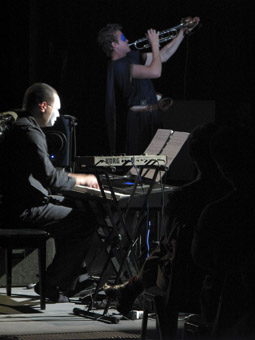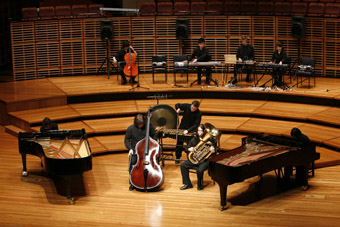stockhausen: visions of light
simon charles: a day of light at the con, smart light festival

Michael Fowler, Tristram Williams, Act II, LICHT
photo SIAL Sound Studios (Lawrence Harvey)
Michael Fowler, Tristram Williams, Act II, LICHT
IN THE ATRIUM OF SYDNEY CONSERVATORIUM, A FANFARE DESCENDS FROM THE UPPER LEVELS, WELCOMING A MIX OF VISITORS AND AUDIENCES TO THE SMART LIGHT FESTIVAL’S STOCKHAUSEN PROGRAM, A DAY OF LIGHT. THE STARK MELODY, MARKED BY VISCERAL BREATH ACCENTS ON PICCOLO, ACCOMPANIED BY CLARINET AND BARITONE SAXOPHONE IS, HOWEVER, VASTLY DIFFERENT FROM A TRADITIONAL PUNCHY, OPTIMISTIC BRASS FANFARE. WHAT BEGINS IN THE ATRIUM CONTINUES ON IN AN UNRELENTING CYCLE, PUNCTUATED BY LONG SILENCES AND TURNING INTO A MUSICAL JUGGERNAUT, SEEMINGLY UNSTOPPABLE AND ALWAYS UNRESOLVED. THIS IS THE LICHT-RUFT (1995), THE EPIC FANFARE INTRODUCTION TO KARLHEINZ STOCKHAUSEN’S SEVEN-DAY OPERA CYCLE, LICHT (LIGHT).
An hour after it began, the fanfare did indeed prove to be unstoppable, as it continued to play while audiences were ushered into a small recital hall to hear two Stockhausen works performed by Ensemble Offspring. Setz Die Segel Zur Sonne (Set sail for the sun), delicately evolved from a contemplative opening ambience. Part of a series of text-based works titled Aus Den Sieben Tage (From the seven days, 1968), this piece was treated with necessary reverence by the performers. The works comprise vague yet poetic guidelines for improvisation, such as “play a note for so long/ until you hear its individual vibrations” and “…slowly move your tone/ until you arrive at a complete harmony/ and the whole sound turns to gold,/ to pure, gently shimmering fire.”
For a composer often identified as belonging to a European avant-garde known for treating every musical parameter with the utmost precision and detail, in this work Stockhausen demonstrates a fierce creativity and extreme openness in finding new musical terrain. In this rendition, the ensemble interacted through subtle sculpting of dynamics and blending of instrumental colour, resulting in a delicate balance and an ethereal quality, never dominated by an individual player.
Tierkreis (Zodiac, 1975), a series of melodies based on the signs of the Zodiac, represented a vastly different compositional approach, the melodic character a radical departure from the textural and atmospheric nature of the opening work. More traditional in comparison with many of Stockhausen’s works, and characterised by unusual scaleic materials and intervallic harmonies, Tierkreis was at times reminiscent of Stravinsky—sometimes haunting and simple, at other times driving and rhythmically complex.
Originally composed for three music boxes as part of a children’s theatre show, these pieces can be performed for any combination of suitable instruments. Ensemble Offspring’s rendition moved through a colourful array of instrumental combinations and playing techniques. Arranged for clarinets, flutes, percussion, piano, toy piano, accordion, melodica and celeste, this version was never dull as new sounds injected fresh energy into the piece throughout. Perhaps the most poignant moment was provided by the sound of a fragile solo music box, seeming all the more vulnerable when exposed by a single spotlight. There were dramatic elements too that breathed additional life into the performance—Clare Edwardes swinging a cowbell while walking through the space and Jason Noble marching around the stage performing a melody on his clarinet.
The creative interpretation of these works conveyed a sense of daring that seemed to be relished by Ensemble Offspring. This was a beautifully curated concert; the material well balanced and standard chamber music conventions interrogated.
The audience emerges into the Atrium, the LICHT fanfare continues. The juggernaut rolls on and already we sense the prolific, intense output of this composer.

Licht
photo David Clare
Licht
Following Ensemble Offspring, The Song Company performed two works, taking us directly into the world of the opera, LICHT. The six-strong company were joined by six vocal students from the Conservatorium to perform Chor-Spirale, from Fritag aus LICHT (Friday of Light, 1994)—”six hybrid couples conceived as six candle flames unite into a single flame, spiralling up into heaven.” The use of glissandi and hissing added new colours to the conventional pallet of unaccompanied voices, and was executed with utmost precision under the direction of the curator of the Day of Light, Roland Peelman. As the piece evolved a solo bass and soprano moved respectively to the lower and upper extremes of their ranges. Towards the end, silences of increasing length added a new dimension, bringing with it a palpable tension.
From Sieben Lieder Der Tage (The Seven Songs of the Days), the Song Company then performed Montag aus LICHT (Monday from Light, 1986) adapted for six singers and piano. Each singer represented a day of the week and dressed in a corresponding colour. This visual element played out further as the singers, in two rows spread out across the stage, stood dead-pan waiting for their solos, all of which were delivered with dramatic poses or gesturing. Against this stark theatricality, the piano accompaniment—characterised by irregular rhythms and a chromatic spectrum of pitch material—maintained an ambling sense of flow.
The centerpiece of the day’s concerts was Act two from Dienstag aus Licht (Tuesday from LICHT, 1990-91), the Australian premiere of part of the cycle. In a darkened studio the work opened with an ominous electronic score. Drones, various timbres and occasional explosive gestures morphed and blended through an eight channel spatial mix, demonstrating Stockhausen’s remarkable skill in sustaining an homogenous texture over such a long duration. Perhaps this dark sound world is symbolic of the mountainside—the focal point in the story of the second act of Dienstag aus Licht.
Camouflaged by the similar pitch space of the electronic score, the sound of a trombone emerges from the mix and Lucifer, played by trombonist Ben Marks, enters. Moving around the stage, up one aisle, behind the audience, back down the other aisle and onto the stage again, all the while Marks performs fragmented phrases made more palpable by a set of gestures that point the trombone in different directions. The short phrases are punctuated further by occasional use of one of several mutes strapped to the player’s waist. It’s as if Lucifer is attempting to break through the mountain—the vast electronic score that continues to surround us. Although not presented in this modestly staged version, the mountainside is penetrated, revealing a metal wall. During a battle between Lucifer and Michael, played by trumpeter Tristram Williams, the wall disintegrates, revealing solid crystal.
A duet follows between the wounded Michael and Eva (Stockhausen’s variation on the biblical Eve), played by soprano Jess Aszodi. By now the electronic score modulates, allowing a greater depth of interaction between the performers and the score itself. Aszodi manages to successfully project her voice through a still very dense sound to blend with Williams’ trumpet. The unusual musical development of this extended piece was at times interspersed with extended techniques such as tongue clicks, whistling and inhalation sounds on the trumpet and might have been more succesful had Aszodi’s voice been amplified to bring greater clarity to these smaller sounds amidst the electronic wash. Nonetheless, her projection was remarkable under the circumstances. Both players conveyed a powerful stage presence through an extreme economy of physical movement.
The electronic score geared up once more and entered into another extended segue, this time in anticipation of Synthi-fou, a trickster figure who distracts the war-makers. Dressed in a multi-coloured robe and surrounded by a multi-synthesizer set-up, Michael Fowler performed this highly complex and intricate music with remarkable showmanship and ease. With manic laughter, over the top gestures and wide-eyed smiles, the eccentric performance culminated in Fowler standing to count down from 13, waving his hand with each count and slowing as he approached one. Synthi-fou’s broad pallet of sounds seemed to interact with and manipulate the electronic score, blending so well that it was, at times, hard to distinguish their source.
The fanfare, concerts, semi-staged opera extract and other events in Day of Light at the Con amply and admirably demonstrated over more than eight hours the epic nature of Stockhausen’s vision. Often the sheer duration of his works conveyed a force almost sufficient to intimidate even a curious and willing audience. As Andrew Ford remarked in his introduction to Ensemble Offspring’s program, Stockhausen’s creativity, now enjoying fresh recognition, was truly fierce and at his death in 2007, we lost a composer like no other.
Smart Light Sydney & Sydney Conservatorium of Music, A Day of Light at the Con, curator Roland Peelman, part of the Vivid Sydney Festival of Music, Light & Ideas, Sydney Conservatorium, June 6
RealTime issue #92 Aug-Sept 2009 pg. 46






